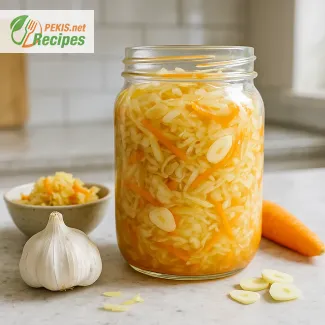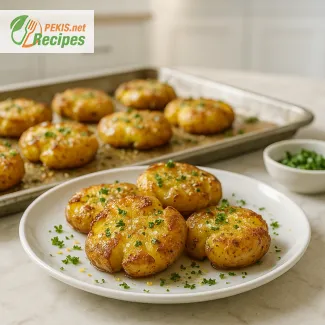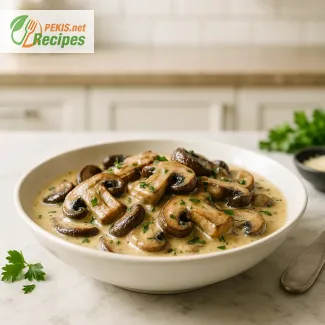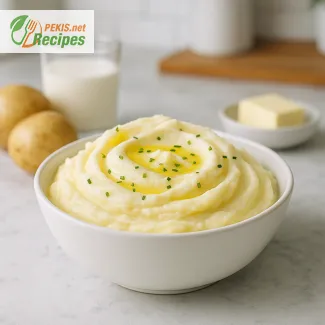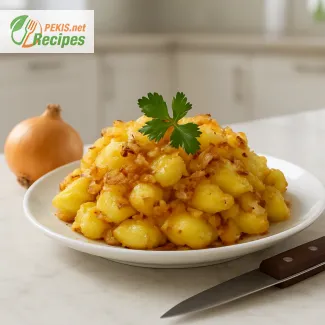Serves 4 people with a total time of just 20 minutes (10 minutes prep, 10 minutes cook). Green beans stay crisp-tender, vibrant, and full of flavor when blanched, then quickly sautéed with garlic, olive oil, and a touch of butter. A squeeze of lemon juice and toasted almonds add freshness and crunch, making it a versatile side for any meal. Can be stored for 2 days at room temperature or frozen for 2 months, then reheated at 150 °C for 8–10 minutes.
PEKIS – professional chef and recipe developer with more than 25 years of experience in baking, specialized in European and international cuisine. For this green bean recipe, I’ve worked with different cooking methods over the years – from steaming to roasting – and found that a balance of blanching and quick sautéing brings out the best flavor and texture. My approach highlights how small details, like adding garlic, a touch of butter, and finishing with lemon juice, can transform a simple vegetable into a side dish that feels both classic and modern.
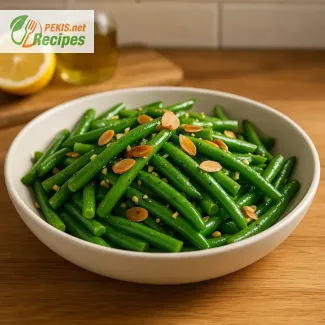
Mastering the art of cooking green beans at home
Techniques, flavors, and culinary inspiration
Green beans, also called string beans or snap beans, are one of the most versatile and beloved vegetables in kitchens around the world. Their crisp texture and naturally fresh taste make them a staple side dish for everyday meals and festive gatherings alike. When cooked correctly, green beans stay vibrant in color, tender to the bite, and full of delicate flavor that pairs beautifully with a wide range of main courses. The process of preparing them may appear simple, yet the difference between undercooked, limp, or perfectly balanced beans lies in mastering a few essential techniques.
The history of green beans traces back to Central and South America, where they were cultivated by ancient civilizations thousands of years ago. Later, they spread across Europe during the 16th century and became a cherished ingredient in Mediterranean cuisine. Over the centuries, they have evolved into countless regional variations – from French-style haricots verts served with butter to traditional American casseroles, or lightly steamed beans dressed with olive oil in Southern Europe. Understanding their cultural journey adds another layer of appreciation when preparing them in your own kitchen.
Why green beans deserve a place in your kitchen
- Versatile pairing with poultry, beef, seafood, or vegetarian dishes.
- Quick preparation makes them ideal for weeknight meals.
- Seasonal freshness available both in summer and as a frozen staple all year round.
- Adaptable flavor that absorbs spices, herbs, or sauces with ease.
Essential cooking approaches for perfect green beans
Achieving the ideal texture and flavor of green beans depends on cooking methods that respect their natural character.
- Blanching helps preserve their bright green color while making them tender yet firm.
- Steaming maintains nutrients and gives beans a pure, clean taste.
- Sautéing with garlic or shallots enhances flavor with subtle aromatic layers.
- Roasting brings a slightly caramelized edge for a deeper, nutty profile.
- Braised variations with tomatoes, onions, or stock transform beans into a comforting side dish.
Each method highlights different qualities – crispness, sweetness, or savory richness – so choosing the right technique allows you to adapt beans to the main dish you are serving.
Why you will love this recipe
- Brings out the natural sweetness of green beans.
- Easy to adapt with spices, herbs, and sauces.
- Works equally well for casual dinners or elegant occasions.
- Balanced between healthy eating and satisfying taste.
Storage and make-ahead tips
Green beans can be stored at room temperature for up to 2 days once cooked, provided they are kept in an airtight container. For longer preservation, freezing is an excellent choice, and beans maintain their quality for about 2 months when frozen after blanching. To reheat, simply place them in a preheated oven at 150 °C (300 °F) for 8–10 minutes until warmed through without losing texture.
Creative variations to explore
- Mediterranean twist: Toss with olive oil, lemon zest, and toasted almonds.
- Asian-inspired: Stir-fry with soy sauce, sesame seeds, and ginger.
- Classic comfort: Add butter, breadcrumbs, and a hint of nutmeg.
- Modern fusion: Combine with roasted peppers and feta for a colorful side.
Flavor companions and culinary context
Green beans act as a natural canvas for many flavor profiles. Herbs such as thyme, dill, and parsley add freshness, while butter, olive oil, and nuts contribute richness and texture. Pairing them with citrus enhances brightness, while a sprinkle of spices like smoked paprika or chili flakes brings warmth and depth. Their subtle taste ensures they can harmonize with bold or delicate dishes, making them a timeless component of diverse culinary traditions.
- Rinse the green beans thoroughly under cold water and trim the ends.
- Bring a large pot of water with salt to a boil.
- Add the green beans and blanch for 3–4 minutes until vibrant green and slightly tender.
- Immediately transfer the beans into a bowl of ice water to stop the cooking process and preserve their color. Drain well.
- In a large skillet, heat olive oil and butter over medium heat.
- Add minced garlic and sauté for about 1 minute until fragrant.
- Toss the drained beans into the skillet and cook for another 4–5 minutes, stirring gently.
- Add lemon juice and season with black pepper.
- Transfer to a serving dish and sprinkle with toasted almonds (for garnish).
FAQ questionHow long should I boil green beans to keep them crisp-tender?
For crisp-tender green beans, cook in well-salted boiling water for 3–4 minutes, then plunge into an ice bath to stop cooking. This keeps the pods bright green and lightly snappy, perfect for finishing with a quick sauté or a simple dressing.
FAQ questionDo I need to blanch green beans before sautéing?
Blanching makes a big difference. Blanch green beans briefly, chill in ice water, then sauté with garlic and olive oil for 2–3 minutes. You’ll get evenly cooked beans with a tender bite and better color retention, without the risk of overcooking while you brown aromatics.
FAQ questionWhat’s the best way to season green beans?
Green beans love garlic, olive oil, a touch of butter, lemon juice, and black pepper. For extra character, add toasted almonds (or seeds), fresh herbs (parsley, dill, thyme), or a pinch of red pepper flakes. A drizzle of good vinegar or citrus zest lifts the flavor without masking the beans’ natural sweetness.
FAQ questionCan I cook green beans from frozen?
Yes—no thawing needed. Spread frozen beans on a hot sheet pan to roast at 220 °C (425 °F) for 12–15 minutes with oil, salt, and pepper, or stir-fry over high heat for 6–8 minutes. Skip blanching; just season at the end with lemon or a splash of soy sauce for brightness.
FAQ questionHow do I keep green beans bright green?
Use plenty of salted water, avoid overcrowding, and don’t overcook. Shock immediately in ice water to lock in the color, then rewarm quickly in a pan with olive oil or butter. Acid (like lemon juice) is best added after cooking to preserve that vivid hue.
FAQ questionHow should I store and reheat cooked green beans?
Keep in an airtight container at room temperature for up to 2 days, or freeze for up to 2 months (best after blanching and drying). Reheat on a tray at 150 °C (300 °F) for 8–10 minutes until warmed through, then finish with lemon and a sprinkle of toasted nuts for texture.
FAQ questionWhat’s the difference between green beans and haricots verts?
Haricots verts are a thinner, more delicate variety that cooks faster (blanch 2–3 minutes). Standard green beans are slightly thicker and take a minute longer. Flavor and uses are similar, so choose by texture preference and desired cooking time.
Green beans remain one of the most reliable and versatile vegetables for everyday cooking. With the right approach, they turn into a vibrant, crisp-tender side dish that enhances both simple family meals and more elaborate occasions. By balancing blanching and quick sautéing, the beans keep their natural sweetness while absorbing layers of flavor from garlic, olive oil, and a touch of butter.
Small adjustments can transform the final result. A squeeze of lemon juice adds brightness, while a sprinkle of toasted almonds brings crunch and richness. The ability to adapt green beans with different herbs, spices, or seasonings makes them a flexible addition to a wide variety of cuisines, from Mediterranean to Asian-inspired dishes.
The convenience of preparing green beans ahead of time makes them practical as well. They can be stored safely, frozen for later use, and reheated without losing texture. This ensures they are not only flavorful but also a smart choice for meal planning.
At the heart of this dish is the balance between simplicity and depth. With only a few key ingredients and straightforward steps, green beans become a nutritious, colorful, and satisfying side that fits effortlessly into modern kitchens while honoring traditional methods.
Allergens present in the recipe:
- Dairy (butter)
- Tree nuts (almonds)
Gluten: This recipe does not contain gluten.
Substitution tips for allergens and gluten:
- Replace butter with dairy-free margarine or extra olive oil for a lactose-free version.
- Replace almonds with pumpkin seeds or sunflower seeds if allergic to tree nuts.
- Vitamin C 12 mg – supports immune system and collagen formation.
- Vitamin K 18 µg – essential for blood clotting and bone health.
- Folate 40 µg – important for cell regeneration and heart health.
- Potassium 230 mg – regulates fluid balance and muscle contractions.
- Iron 1.5 mg – contributes to oxygen transport in the blood.
- Magnesium 25 mg – supports nerve function and energy production.
- Calcium 40 mg – strengthens bones and teeth.
- Lutein 200 µg – protects eyes from oxidative stress.
- Beta-carotene 250 µg – supports skin health and immune function.
- Chlorophyll 300 µg – detoxifying properties and supports cellular health.
